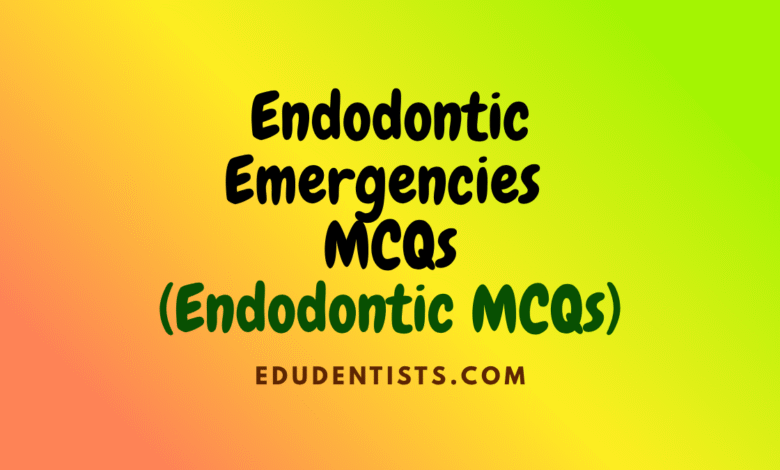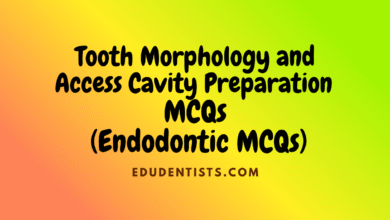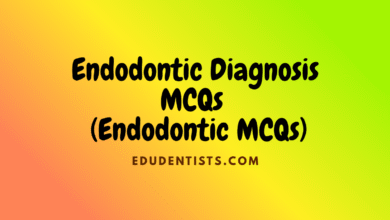Endodontics MCQs
Endodontic Emergencies MCQs (Endodontic MCQs)
Endodontic Emergencies MCQs (Endodontic MCQs)

Endodontic Emergencies MCQs _ Endodontic MCQs
Endodontic Emergencies MCQs _ Endodontic MCQs
- What is the difference between a true endodontic emergency & urgency ?
A. True emergency may be rescheduled for convenience of the patient.
B. True emergency is a condition requiring an unscheduled office visit.
C. Urgency indicates a more severe problem.
D. Urgency may need to be seen after normal office hours. - In a true emergency, how many teeth are usually involved?
A. One tooth
B. Two teeth
C. Often several teeth throughout the mouth
D. Often teeth in only one quadrant - Which is not an important factor in assessing the quality and quantity of pain?
A. Spontaneity
B. Time of day of occurrence
C. Intensity
D. Duration - Which is not an immediate goal of emergency treatment plan?
A. Reducing the irritant
B. Reduction of pressure
C. Pharmacotherapeutic management of swelling
D. Removal of the inflamed pulp or periradicular tissue - The most critical factor in a pretreatment emergency is?
A. Adequate health history
B. Pain management
C. Patient management
D. Adequate provisional restoration - Which is the preferred treatment for an emergency appointment with symptomatic apical periodontitis and with a diagnosis of irreversible pulpitis?
A. Caries excavation with provisional restoration
B. Partial or total pulpectomy
C. Trephination through the mucosa and bone
D. Pharmaceutical management of swelling - What is the emergency treatment of choice for pulp necrosis with no swelling?
A. Trephination for drainage
B. Pulpotomy
C. Canal debridement to corrected working length
D. Single visit root canal treatment - An incision for drainage may be indicated for patient present with localized swelling. What does drainage accomplish?
A. Patient reassurance and management
B. Allows administration of anesthetic solution to the apex
C. Decrease in blood flow to the area
D. Removal of a very potent irritant-purulence - At an emergency appointment, should teeth be left open to drain?
A. Yes, only if there is swelling.
B. Yes, only if there is no swelling.
C. No, teeth should have an inter-appointment temporary restoration placed. - What is the most important consideration of administering antibiotics with a localized apical abscess?
A. The dosage should be for 10 days.
B. It should be a broad-spectrum antibiotic.
C. The dosage levels should be higher than usual.
D. Antibiotics are ineffective and should not be prescribed. - The incidence of inter-appointment flare-ups?
A. Primarily after obturation at a range of 4.4 to 6.0%
B. Overall at a range of 1.8 to 3.2%
C. Overall at a range of 10.7 to 21.3%
D. Primarily after vital pulp removal at a range of 7.5 to 10.7% - Which of the following has been identified as significant factor related flare ups?
A. Teeth with vital pulps
B. Teeth without periradicular radiolucency
C. Patient presenting with preoperative pain or swelling
D. Completing endodontic treatment in a single visit - What is a consideration of postobturation emergencies?
A. More common than flare-ups following cleaning and shaping
B. Infrequent and usually resolve spontaneously
C. Approximately 10% to 15% occurrence
D. Often require nonsurgical root canal retreatment - Which of the following statements about the degree of pulp pathosis is correct:
A. It can be determined by the level of pain a patient experiences.
B. It can be related to the level of response of the electrical pulp tester.
C. It can be correlated best when a diagnosis of irreversible pulpitis is established.
D. It does not correlate well with the level of pain a patient perceives. - Which of the following is a key measure of the degree (intensity) of pain:
A. Painful stimulus with cold
B. Painful stimulus with heat
C. Painful stimulus on biting
D. Increasing pain
E. Pain that affects the patients lifestyle - In a true endodontic emergency, if the patient cannot localize the pain
A. More than one tooth is likely to be involved.
B. The patient should be dismissed with instructions to return when the pain localizes.
C. Pulp tests will be of little benefit.
D. Only one tooth likely is responsible.
E. Treatment should be started on more than one tooth. - A painful irreversible pulpitis on a mandibular molar may not have profound anesthesia when the access is initiated. Which of the following may contribute to poor anesthesia:
A. low tissue pH
B. alterations in sodium channels
C. inflammatory mediator actions
D. all of the above - When a dental emergency is treated, a complete medical history is essential to:
A. Identify patients with conditions that may contraindicate root canal treatment
B. Determine conditions that might require modifications in the approach to treatment
C. Protect the health care team from possible blood-borne pathogens and other infectious diseases the patient may have
D. Ensure medical-legal protection and determine whether the patients medical status will affect the prognosis for root canal treatment
E. All of the above - Which of the following is true when a patient complains of severe pain that cannot be localized
A. The pain is most likely periradicular in origin and likely to persist even when the necrotic pulp is removed.
B. Treatment procedures should be delayed and the condition managed with analgesic medications.
C. The cause is most likely nonodontogenic in origin.
D. Selective administration of a local anesthetic can lead to a definitive diagnosis.
E. The pulp of more than one tooth is involved, and the pathoses produces a synergistic hyperalgesia response in the central nervous system (CNS). - A patient complains of pain on biting and of sensitivity to cold in the maxillary left posterior quadrant that subsides within seconds of removal of the stimulus. Clinical examination reveals that teeth 2 and 3 have occlusal amalgams. Which of the following tests or actions are most appropriate based on the chief complaint:
A. Periapical radiographs of the posterior teeth
B. Examination using transillumination
C. Electrical pulp testing
D. Percussion and palpation testing - Administration of antibiotics is contraindicated in irreversible pulpitis because they:
A. Are ineffective
B. Allow superbugs to mutate in the pulp
C. Mask the symptoms but do not resolve the problem
D. Suppress the immune system - In an emergency, a general practitioner should consider referring a patient to an endodontist under what circumstance
A. Previous endodontic treatment
B. Localized swelling
C. Irreversible pulpitis in a second molar
D. Acute apical abscess with a lesion that extends over adjacent teeth - A patient describes pain on chewing and sensitivity to cold that goes away immediately with removal of the stimulus. The mandibular left second molar (tooth 18) shows a mesioocclusal (MO) crack. The tooth is caries free, and no restorations are present. Periodontal probing depths are 3mm or less. Which of the following statements is correct
A. The pulpal diagnosis is normal pulp, and the tooth should be prepared and restored with a MO-bonded amalgam.
B. The pulpal diagnosis is reversible pulpitis, and the tooth should be restored with a crown.
C. The pulpal diagnosis is irreversible pulpitis, and root canal treatment should be performed, a bonded amalgam placed, and a crown fabricated.
D. A radiograph will probably will reveal a radiolucent area associated with the mesial root.
E. The prognosis for the tooth is unfavorable. - Treatment of severe, throbbing pain associated with irreversible pulpitis of the maxillary left first molar (tooth 14) is best managed by:
A. Pulpotomy
B. Partial pulpectomy
C. Pulpectomy
D. Analgesic agents
E. Analgesic and antibiotic agents - Which of the following statements is accurate with regard to leaving a tooth open for drainage in cases of irreversible pulpitis:
A. It is the recommended method of managing an emergency patient.
B. It may adversely affect the outcome of treatment.
C. It is appropriate if antibiotic therapy is also started.
D. It should be considered in addition to soft tissue incision and drainage. - With an acute apical abscess, administration of antibiotics is indicated
A. Primarily only when diffuse swelling is present
Explanation: Refer to page 52
B. When swelling to any degree (localized or diffuse) is present
C. Two to 3 days before treatment of the tooth is started
D. Only if purulent drainage from an incision is noted - A patient requires emergency treatment of a fluctuant swelling over the facial alveolar process of the maxillary left lateral incisor (tooth). Which of the following statements is correct about performing incision and drainage:
A. The incision should not go directly to bone.
B. The incision should be made horizontally in the attached gingiva at the base of the swelling.
C. If drainage occurs with the initial incision, blunt dissection is not necessary.
D. The incision should be made at the site of greatest fluctuance. - Incision for drainage of an indurated swelling:
A. Should be delayed until the swelling becomes fluctuant
B. Can reduce pain caused by tissue distention
C. Usually releases a purulent exudate for culture and sensitivity testing
D. Is not indicated, because antibiotic treatment will resolve the lesion - Of the following intracanal medicaments, which is most effective at controlling pain after treatment of necrotic pulpacute apical abscess
A. Formocresol
B. Eugenol
C. Camphorated monochlorophenol
D. Calcium hydroxide
E. None of these medicaments control pain. - For which of the following reasons is apical trephination through the faciobuccal cortical plate advocated:
A. To release exudate when the lesion is close to perforating the cortical bone
B. As a routine procedure to relieve pain when the affected tooth has been obturated
C. As a treatment for severe recalcitrant pain
D. To prevent a flare-up between multiple-visit endodontic procedures - A 22-year-old man requires root canal treatment for pain and swelling in the mandibular anterior area. He notes that his dentist has been treating teeth 25 and 26 for several months and that swelling has occurred after each visit for cleaning and shaping. Clinical examination reveals swelling on the alveolar process in the area of the incisor teeth. Teeth 25 and 26 are tender to palpation and percussion. Which of the following actions should the clinician should take:
A. Perform diagnostic tests on the other incisors
B. Open teeth 25 and 26, debride them, and place calcium hydroxide as an antimicrobial intracanal medicament
C. Open teeth 25 and 26, debride them, and perform incision and drainage
D. Open teeth 25 and 26, debride them, and leave the teeth open for drainage
E. Perform incision and drainage and prescribe an antibiotic for supportive care - A cusp fractures in a noncarious, nonrestored premolar such that dentin is exposed. When the exposed dentin comes in contact with cold fluids, the patient experiences brief, sharp pain. This pulp status is likely which of the following:
A. Normal and uninflamed
B. Reversibly inflamed
C. Irreversibly inflamed
D. Innervated only by A-delta fibers - Which of the following is the primary pharmacologic effect of nonsteroidal antiinflammatory drugs (NSAIDs):
A. Antimicrobial effect
B. Analgesic effect
C. Antiinflammatory effect
D. Reduction of swelling
E. Prevention of the spread of infection





